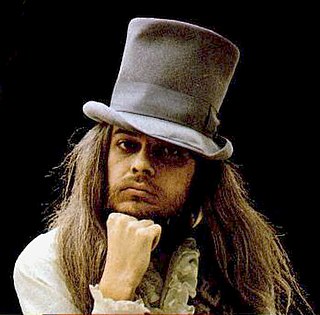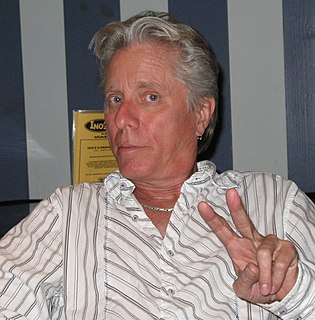
John Weldon "J. J." Cale was an American guitarist, singer, and songwriter. Though he avoided the limelight, his influence as a musical artist has been widely acknowledged by figures such as Mark Knopfler, Neil Young and Eric Clapton, who described him as "one of the most important artists in the history of rock". He is considered to be one of the originators of the Tulsa Sound, a loose genre drawing on blues, rockabilly, country, and jazz.

Leon Russell was an American musician and songwriter who was involved with numerous bestselling pop music records during his 60-year career. His genres included pop, country, rock, folk, gospel, bluegrass, rhythm and blues, folk rock, blues rock, surf, standards, and Tulsa Sound.
While the music of Oklahoma is relatively young, Oklahoma has been a state for just over 100 years, and it has a rich history and many fine and influential musicians.
Don Roscoe Joseph III, professionally known as Rocky Frisco and Rocky Curtiss, was an American musician. He was best known as the longtime pianist for J. J. Cale, and for his role in the development of the music style known as the Tulsa Sound.

Paul Steven Ripley was an American recording artist, record producer, songwriter, studio engineer, guitarist, and inventor. He entered the music industry in 1977. He was also the leader/producer of country rock band The Tractors.
Carl Dean Radle was an American bassist who toured and recorded with many of the most influential recording artists of the late 1960s and 1970s. He was posthumously inducted to the Oklahoma Music Hall of Fame in 2006.

Eric Clapton is the debut solo studio album by British rock musician Eric Clapton, released in August 1970 under Atco and Polydor Records.
Red Dirt is a music genre that gets its name from the color of soil found in Oklahoma. Stillwater, Oklahoma is considered to be the center of red dirt music ; but the genre also extends to music made south of the Red River in Texas. Outlaw country legends Waylon Jennings and Willie Nelson have been associated with the distinctive Texas Sound, while the late Oklahoma singer-songwriter Bob Childers is widely recognized as the Father of Oklahoma Red Dirt music. At one time, the distinction between the two genres was sonically obvious, but by 2008, that gap had diminished.

Naturally is the debut studio album by J. J. Cale released in 1972.
Thomas Edison Preparatory School is a public school located in midtown Tulsa, Oklahoma serving students from the 6th grade to the 12th grade.

5 is the fifth studio album by J. J. Cale. Released in 1979, it was his first album in three years. When the album was re-issued on CD, "Katy Kool Lady" was replaced by a new song listed as "Out of Style," though it was still listed as the former on the CD. "Out of Style" is also included on the 2007 album Rewind: The Unreleased Recordings under its proper title. There is still no U.S. domestic release of the song "Katy Kool Lady" on CD.

Don Preston is an American guitarist, singer, and songwriter whose career parallels the history of rock 'n' roll from the 1950s to the present. He notably recorded in the 1970s with Leon Russell on Leon Russell and the Shelter People and other albums, and with Joe Cocker on Mad Dogs and Englishmen. He backed Russell at George Harrison's Concert for Bangladesh in August 1971 and appeared in the documentary film and on the live album The Concert for Bangladesh.

James Oldaker is an American rock music, blues rock and country music drummer and percussionist. He is an exponent of the shuffle style. He is married to Mary Billings Oldaker.
David Teegarden is a member of the 1960s and 1970s psych-rock group Teegarden & Van Winkle. He is a resident of Tulsa, Oklahoma. Teegarden has worked with many musicians including J. J. Cale, Eric Clapton, Joe Walsh, and Bob Seger. In 1981, Teegarden won a Grammy for Best Rock Performance by a Duo or Group with Vocal for Against the Wind with Bob Seger & the Silver Bullet Band.
The Oklahoma Music Hall of Fame, located in Muskogee, Oklahoma, honors Oklahoma musicians for their lifetime achievements in music. The induction ceremony and concert are held each year in Muskogee. Since its establishment in 1997, the Hall of Fame has inducted more than 37 individuals or groups, produced more than 7 concerts, and renovated in part the facility that will educate Oklahomans for generations about those innovators and industry icons from Oklahoma.
Haskell Clyde Stacy, known as Clyde Stacy, was an American rockabilly singer and guitarist who recorded in the 1950s as the leader of Clyde Stacy & The Nitecaps. He is credited as a founder of the "Tulsa Sound".

The Church Studio is a recording studio housed in an old church in Tulsa, Oklahoma. During the 1970s it became closely associated with its owner, recording artist Leon Russell, and with the genre of music known as the Tulsa Sound.
Brandon Dean Jenkins was an American singer-songwriter and philanthropist. He was part of the Red Dirt music genre.

Stop All That Jazz is an album by singer and songwriter Leon Russell. The album was recorded in 1974 at Leon Russell's House Studio, Tulsa, OK, Paradise Studios, Tia Juana, OK, Pete's Place, Nashville, TN and Shelter The Church Studio, Tulsa, OK. Stop All That Jazz is Russell's sixth solo album.









